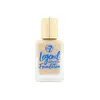What's inside
What's inside
 Key Ingredients
Key Ingredients

 Benefits
Benefits

 Concerns
Concerns

 Ingredients Side-by-side
Ingredients Side-by-side

Water
Skin ConditioningIsododecane
EmollientGlycerin
HumectantDimethicone
EmollientVinyl Dimethicone/Lauryl Dimethicone Crosspolymer
Cyclopentasiloxane
EmollientPvp
Emulsion StabilisingSilica
AbrasivePhenoxyethanol
PreservativeEthylhexylglycerin
Skin ConditioningPEG-10 Dimethicone
Skin ConditioningDisteardimonium Hectorite
StabilisingPanthenol
Skin ConditioningDisodium EDTA
Tocopheryl Acetate
AntioxidantCI 77891
Cosmetic ColorantIron Oxides
CI 77491
Cosmetic ColorantCI 77492
Cosmetic ColorantCI 77499
Cosmetic ColorantWater, Isododecane, Glycerin, Dimethicone, Vinyl Dimethicone/Lauryl Dimethicone Crosspolymer, Cyclopentasiloxane, Pvp, Silica, Phenoxyethanol, Ethylhexylglycerin, PEG-10 Dimethicone, Disteardimonium Hectorite, Panthenol, Disodium EDTA, Tocopheryl Acetate, CI 77891, Iron Oxides, CI 77491, CI 77492, CI 77499
Water
Skin ConditioningCyclopentasiloxane
EmollientCyclohexasiloxane
EmollientPhenyl Trimethicone
Skin ConditioningPropylene Glycol
HumectantIsododecane
EmollientCetyl PEG/PPG-10/1 Dimethicone
EmulsifyingGlycerin
HumectantTribehenin
EmollientCetyl Ethylhexanoate
EmollientHydrogenated Polyisobutene
EmollientPhenoxyethanol
PreservativeSilica Dimethyl Silylate
EmollientPolyglyceryl-4 Isostearate
EmulsifyingHexyl Laurate
EmollientDisteardimonium Hectorite
StabilisingNiacinamide
SmoothingAlcohol Denat.
AntimicrobialTriethoxycaprylylsilane
Ethylhexylglycerin
Skin ConditioningDisodium EDTA
Trimethoxycaprylylsilane
SmoothingCentaurea Cyanus Flower Extract
AstringentParfum
MaskingTalc
AbrasiveLinalool
PerfumingCI 77891
Cosmetic ColorantIron Oxides
Water, Cyclopentasiloxane, Cyclohexasiloxane, Phenyl Trimethicone, Propylene Glycol, Isododecane, Cetyl PEG/PPG-10/1 Dimethicone, Glycerin, Tribehenin, Cetyl Ethylhexanoate, Hydrogenated Polyisobutene, Phenoxyethanol, Silica Dimethyl Silylate, Polyglyceryl-4 Isostearate, Hexyl Laurate, Disteardimonium Hectorite, Niacinamide, Alcohol Denat., Triethoxycaprylylsilane, Ethylhexylglycerin, Disodium EDTA, Trimethoxycaprylylsilane, Centaurea Cyanus Flower Extract, Parfum, Talc, Linalool, CI 77891, Iron Oxides
 Reviews
Reviews

Ingredients Explained
These ingredients are found in both products.
Ingredients higher up in an ingredient list are typically present in a larger amount.
Ci 77891 is a white pigment from Titanium dioxide. It is naturally found in minerals such as rutile and ilmenite.
It's main function is to add a white color to cosmetics. It can also be mixed with other colors to create different shades.
Ci 77891 is commonly found in sunscreens due to its ability to block UV rays.
Learn more about CI 77891Cyclopentasiloxane, or D5, is a silicone used to improve texture of products and trap moisture.
D5 is considered lightweight and volatile. Volatile means it evaporates quickly after application. Once evaporated, D5 leaves a thin barrier that helps keep skin hydrated.
It is also an emollient. Emollients help soften the skin and prevent water loss. Silicones create a silky texture in products. D5 helps other ingredients become more spreadable.
Studies show D5 is safe to use in skincare products. We recommend speaking with a skincare professional if you have concerns.
Learn more about CyclopentasiloxaneDisodium EDTA plays a role in making products more stable by aiding other preservatives.
It is a chelating agent, meaning it neutralizes metal ions that may be found in a product.
Disodium EDTA is a salt of edetic acid and is found to be safe in cosmetic ingredients.
Learn more about Disodium EDTADisteardimonium Hectorite comes from the clay mineral named hectorite. It is used to add thickness to a product.
It can also help stabilize a product by helping to disperse other ingredients.
Hectorite is a rare, white clay mineral.
Learn more about Disteardimonium HectoriteEthylhexylglycerin (we can't pronounce this either) is commonly used as a preservative and skin softener. It is derived from glyceryl.
You might see Ethylhexylglycerin often paired with other preservatives such as phenoxyethanol. Ethylhexylglycerin has been found to increase the effectiveness of these other preservatives.
Glycerin is already naturally found in your skin. It helps moisturize and protect your skin.
A study from 2016 found glycerin to be more effective as a humectant than AHAs and hyaluronic acid.
As a humectant, it helps the skin stay hydrated by pulling moisture to your skin. The low molecular weight of glycerin allows it to pull moisture into the deeper layers of your skin.
Hydrated skin improves your skin barrier; Your skin barrier helps protect against irritants and bacteria.
Glycerin has also been found to have antimicrobial and antiviral properties. Due to these properties, glycerin is often used in wound and burn treatments.
In cosmetics, glycerin is usually derived from plants such as soybean or palm. However, it can also be sourced from animals, such as tallow or animal fat.
This ingredient is organic, colorless, odorless, and non-toxic.
Glycerin is the name for this ingredient in American English. British English uses Glycerol/Glycerine.
Learn more about GlycerinIsododecane is a fragrance, emollient, and solvent.
As an emollient, it helps your skin stay soft and hydrated. Emollients help trap moisture into your skin.
Isododecane's role as a solvent makes it a great texture enhancer. It spreads smoothly on skin and does not leave a sticky feeling behind. Isododecane also helps prevent color transfer in makeup products.
Isododecane is not absorbed into skin.
Learn more about IsododecanePhenoxyethanol is a preservative that has germicide, antimicrobial, and aromatic properties. Studies show that phenoxyethanol can prevent microbial growth. By itself, it has a scent that is similar to that of a rose.
It's often used in formulations along with Caprylyl Glycol to preserve the shelf life of products.
Water. It's the most common cosmetic ingredient of all. You'll usually see it at the top of ingredient lists, meaning that it makes up the largest part of the product.
So why is it so popular? Water most often acts as a solvent - this means that it helps dissolve other ingredients into the formulation.
You'll also recognize water as that liquid we all need to stay alive. If you see this, drink a glass of water. Stay hydrated!
Learn more about WaterThis ingredient is a combination of red, black, and yellow iron oxide pigments. This combination of colors is usually found in foundation, because it results in a "skin" color.